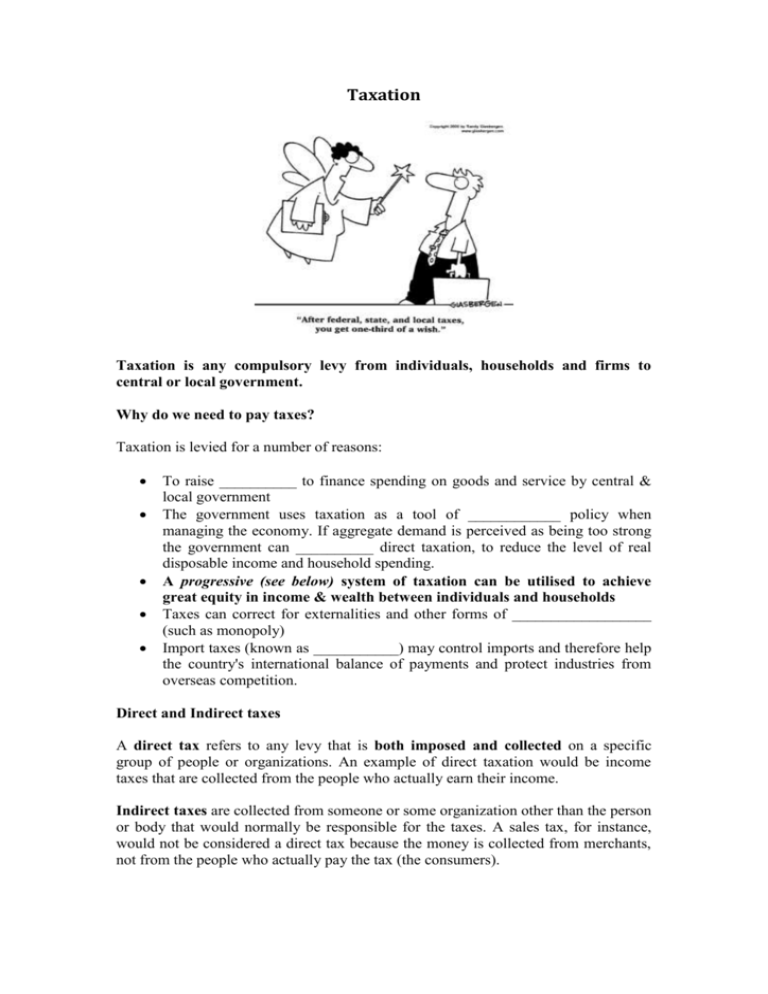Proportional taxes
advertisement

Taxation Taxation is any compulsory levy from individuals, households and firms to central or local government. Why do we need to pay taxes? Taxation is levied for a number of reasons: To raise __________ to finance spending on goods and service by central & local government The government uses taxation as a tool of ____________ policy when managing the economy. If aggregate demand is perceived as being too strong the government can __________ direct taxation, to reduce the level of real disposable income and household spending. A progressive (see below) system of taxation can be utilised to achieve great equity in income & wealth between individuals and households Taxes can correct for externalities and other forms of __________________ (such as monopoly) Import taxes (known as ___________) may control imports and therefore help the country's international balance of payments and protect industries from overseas competition. Direct and Indirect taxes A direct tax refers to any levy that is both imposed and collected on a specific group of people or organizations. An example of direct taxation would be income taxes that are collected from the people who actually earn their income. Indirect taxes are collected from someone or some organization other than the person or body that would normally be responsible for the taxes. A sales tax, for instance, would not be considered a direct tax because the money is collected from merchants, not from the people who actually pay the tax (the consumers). Direct taxes include: Income tax Income tax is a direct tax on all incomes received by private individuals after certain allowances are made. Often a certain amount of a person’s income will be tax free. Income over this amount is known as taxable income. National insurance/social security contributions A direct proportional tax (see later) taken off the earnings of those people in employment. Employers also pay contributions for each worker they employ. (Many workers in China and Hong Kong make contributions towards retirement funds). Corporate tax/Business tax Tax on the profits of companies whether the profits are earned home or abroad - a proportional tax. In Hong Kong, the rate is 16.5%. (In China it is 25%). Inheritance Tax? Capital Gains Tax? Indirect taxes include: VAT/Sales tax/Goods & Services tax These are consumption taxes and occur when a good/service is sold to the consumer. In China the rate of VAT is 17%, in the UK it is 20% and in Korea it is 10%. Hong Kong does not charge any VAT/GST. Excise duties These are taxes, charged in addition to VAT, primarily on gasoline, alcohol and tobacco (commonly referred to as sin taxes). They are a specific tax- charged per unit or volume consumed as opposed to ad valorem tax. General Revenue 350 %) ion Salaries Tax (22.8%) Stamp Duty (17.0%) Betting Duty (7.4%) Others (3.2%) 2013-14 (69.1%) 2012-13 ns 349 Import taxes Figure 3 Composition of the revenue collections These, as their name implies, are taxes on specific types of imports. (69.7%) 2013-14 Profits Tax (49.6%) Other General Revenue Figure 4 The chart on the right shows the composition of tax revenue by source in Hong Kong. As is evident, there is no__________ tax charged in Hong Kong. The pictorial below shows how much excise duty and VAT makes up the price of a pack of cigarettes in UK. Progressive, Regressive and Proportional taxes Income tax is a progressive tax. This means that as income rises the proportion or percentage of income paid in taxation rises. So, in Hong Kong, the first HK$40,000 of a person’s annual income is taxed at 2% (marginal rate of tax), the next HK$40,000 at 7%, the next HK$40,000 at 12% and any remaining salary above that is taxed at 17%. Because the marginal rate of tax rises at certain levels of taxable income, the average rate of tax paid also rises with income. 0 TAX BANDS 80,000 40,000 120,000 YEARLY INCOME (HK$) 2% 7% 12% 17% MARGINAL RATE OF TAX Using the tax bands and marginal tax rates for Hong Kong, complete the following table for maximum marginal rax rate, tax payable and average tax rate. The first example has been done for you. Taxable Income (HK $ per year) 50,000 100,000 300,000 5,000,000 Max. marginal Tax rate 7% Tax Payable (HK$) 800 + 700= 1500 Average tax rate = Tax payable/ taxable income 3% In China, the marginal tax rates for monthly income are shown as follows: (note there is a tax exemption of 3500 for regular employees- this means that if an employee earned 10,000 RMB per month, he/she would be exempt from paying tax on 3500 and would pay tax on 6,500 instead). from [RMB] 0 1500 4500 9000 35000 55000 80000 Income (Rmb per month) 8,000 15,000 30,000 100,000 to [RMB] 1500 4500 9000 35000 55000 80000 over Exemp tion Taxable income 3,500 3,500 3,500 3,500 4,500 Marginal tax rate [%] 3 10 20 25 30 35 45 Max. marginal Tax rate 10% Tax Payable (Rmb) Average tax rate = Tax payable/ taxable income Proportional taxes A tax is proportional when all taxpayers pay the same percentage of their income or wealth. Corporation tax and national insurance are examples. In the example below, corporation tax is set at 25% of profits. Taxable profits RMB 400,000 Tax rate Tax payable (RMB) 25% 600,000 900,000 5,000,000 Regressive taxes Generally, indirect taxes are seen as regressive; the proportion of income paid in tax decreases as income rises. Regressive taxes will take a greater percentage of income or wealth from the poor. Sales tax/VAT is generally seen a regressive as those on low incomes will inevitably spend more of their income than those on high incomes. Low income families will have a higher ____________. Income /- VAT Taxable expenditure 40,000 40,000 20% 60,000 50,000 20% 90,000 70,000 20% 500,000 300,000 20% Tax payable Tax paid as % of income








